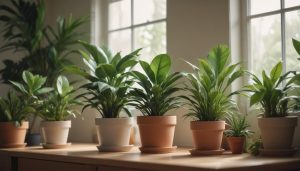Interior Design Approaches That Boost Happiness
Jessica White August 15, 2025
In recent years, interior design has shifted from focusing merely on aesthetics to considering how our living spaces can enhance our well-being. The idea that our surroundings directly impact our happiness is not just a passing trend—it’s becoming a fundamental aspect of modern interior design. From biophilic design to minimalist principles, the way we approach our home spaces can play a significant role in boosting our mood and emotional health. In this article, we will explore the most current trends in interior design that focus on happiness and how you can implement them in your own home to create a more joyful environment.

Why Interior Design Affects Happiness
Interior design isn’t just about arranging furniture or picking out color schemes; it’s about crafting a space that supports both your physical and emotional needs. Research has shown that the environment we live in has a profound effect on our mood, energy levels, and mental health. Well-designed spaces can reduce stress, improve productivity, and encourage relaxation. Furthermore, design choices that promote a sense of belonging, comfort, and connection to nature are integral to fostering a positive emotional environment.
With this in mind, here are a few emerging interior design approaches that have been shown to boost happiness and well-being.
1. Biophilic Design: Bringing Nature Inside
Biophilic design, which emphasizes the connection between humans and nature, is gaining significant traction. This approach includes using natural elements such as plants, wood, and stone to create environments that mimic the outdoors. Studies have found that being in spaces that incorporate nature can lower stress levels, improve concentration, and enhance overall happiness. One study by the University of Queensland found that spending time in natural settings can significantly boost mental well-being by reducing stress and improving mood.
How to Incorporate Biophilic Design:
- Plants and Greenery: Adding plants is one of the easiest ways to introduce biophilic design. Not only do they purify the air, but they also promote relaxation and creativity. Consider incorporating large indoor plants like fiddle leaf figs, rubber plants, or succulents.
- Natural Materials: Opt for furniture made from wood, stone, or bamboo to add an earthy feel to your home. Textiles like wool or linen also evoke a sense of natural comfort.
- Views and Lighting: Position furniture near windows to maximize natural light and views of the outdoors. If your home lacks natural views, try using nature-inspired artwork or wall murals.
2. Minimalism: Less Clutter, More Peace
In a world that’s often chaotic and overstimulating, the minimalist design approach has become a popular way to create calm and balance. Minimalism focuses on simplifying your surroundings by reducing unnecessary items and choosing only functional, beautiful pieces. The idea is that less clutter leads to less distraction and more mental clarity, which can help reduce anxiety and improve overall happiness.
How to Create a Minimalist Space:
- Declutter: Start by removing items that don’t serve a purpose. Keep only the essentials and items that bring you joy.
- Neutral Color Palette: Minimalist design often uses soft, neutral colors like whites, grays, and beiges. These colors have been shown to promote calmness and tranquility.
- Quality over Quantity: Invest in high-quality furniture and décor pieces that are timeless, functional, and durable. Choose pieces that are not only aesthetically pleasing but also serve a purpose.
3. Personalization: Creating a Sense of Belonging
One of the most powerful ways to boost happiness through interior design is to create a space that feels personal and connected to your identity. Personalization in design goes beyond simply displaying family photos—it’s about making your space reflect your tastes, memories, and experiences. Studies show that personalized spaces foster a sense of ownership and control, which can enhance feelings of security and happiness.
How to Personalize Your Home:
- Display Meaningful Artwork and Photos: Surround yourself with art or photographs that evoke positive memories or emotions. Displaying personal items helps create a connection between your environment and your personal story.
- Use Color to Reflect Your Personality: Color psychology suggests that different colors can evoke different emotions. For example, blues and greens promote calm, while yellows and oranges can create energy and happiness. Choose colors that resonate with you personally.
- Incorporate Your Hobbies and Interests: Whether it’s displaying a collection of books, musical instruments, or travel souvenirs, make space for items that reflect your passions and interests.
4. Mindful Design: Creating a Zen Space
The concept of mindfulness has become incredibly popular in recent years, with more and more people incorporating mindfulness practices into their daily routines. Mindful design focuses on creating spaces that encourage presence, peace, and reflection. The key is to design spaces that are uncluttered, well-organized, and designed to foster calmness and focus.
How to Foster Mindfulness in Your Home:
- Create a Dedicated Space for Relaxation: This could be a reading nook, a meditation area, or even a corner with comfortable seating where you can pause and breathe.
- Use Soft, Calming Colors: Soft hues like pale blue, lavender, and soft greens can encourage a sense of calm and peace.
- Integrate Textures and Soft Lighting: Soft lighting, such as table lamps or dimmable overhead lights, can help create a relaxed, serene atmosphere. Additionally, incorporating soft textures—think plush rugs, cushions, and throw blankets—can make a space feel more inviting and comforting.
5. Sustainability: Designing with Purpose
Sustainability in design is another growing trend that contributes to both happiness and environmental well-being. As people become more conscious of their environmental impact, sustainable design practices are being embraced by homeowners and interior designers alike. Living in an eco-friendly, sustainable environment not only feels good for the planet but can also create a deeper sense of satisfaction and happiness.
How to Make Your Home More Sustainable:
- Use Eco-friendly Materials: Opt for furniture and décor made from sustainable materials, such as bamboo, reclaimed wood, and organic cotton.
- Energy-efficient Lighting: Switching to LED bulbs or other energy-efficient lighting options reduces your environmental footprint and lowers energy costs.
- Repurpose and Upcycle: Consider repurposing old furniture or décor pieces rather than buying new. Upcycling adds a personal touch and promotes sustainability.
6. Space for Socializing: Building Connection
Humans are inherently social creatures, and the spaces we live in should reflect our need for connection. Creating spaces that are designed for socializing and sharing moments with loved ones can greatly improve happiness. Open layouts, large dining tables, and cozy seating areas encourage conversation, laughter, and bonding—ingredients that are essential for a joyful life.
How to Create Social Spaces:
- Open Floor Plans: Open spaces allow for easy flow between rooms, making it easier to entertain and engage with guests. Consider removing walls or using room dividers to create an open, airy feel.
- Comfortable Seating Arrangements: Arrange furniture to encourage conversation. Large sofas, comfortable armchairs, and even floor cushions can create inviting spaces for socializing.
- Create a Dining Area: A large dining table that accommodates family and friends promotes bonding during meals. It’s a simple yet effective way to bring people together.
Conclusion
Designing a space that nurtures happiness goes beyond visual appeal—it’s about creating an environment that supports your emotional and mental well-being. Whether it’s through biophilic design, minimalist principles, or personalized touches, the way we design our homes can significantly affect how we feel. By incorporating these emerging trends and thoughtful design principles, you can create a home that not only looks beautiful but also promotes a sense of peace, comfort, and happiness.
References:
- Kellert, S.R., & Calabrese, E.F. (2015). The Biophilia Effect: A Scientific and Spiritual Exploration of the Healing Bond Between Humans and Nature. Available at: https://www.biophilia.net (Accessed: 15 August 2025).
- Smith, M. (2019). “How Minimalism Can Improve Your Happiness”. Available at: https://www.journalofinteriordesign.com (Accessed: 15 August 2025).
- Thompson, C. (2020). The Power of Personalization in Interior Design. Available at: https://www.harpercollins.com (Accessed: 15 August 2025).






